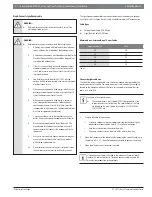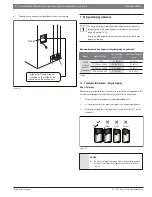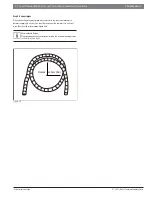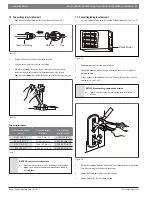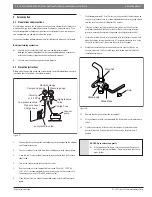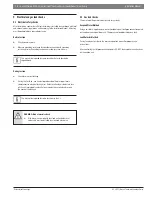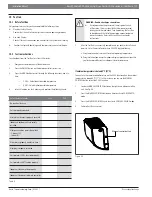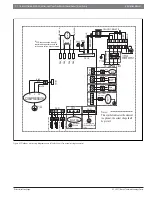
2 6 |
Bosch Climate 5000 AA Series Split Type Ductless Air Conditioner / Heat Pump
Installation Manual
01.2017
|
Bosch Thermotechnology Corp.
Data subject to change
8 Air evacuation
8.1 Preparations and precautions
Air and foreign matter in the refrigerant circuit can cause abnormal rises in pressure,
which can damage the air conditioner, reduce its effi ciency, and cause injury. Use a
vacuum pump and manifold gauge to evacuate the refrigerant circuit, removing any
non-condensable gas and moisture from the system.
Evacuation should be performed upon initial installation and when unit is relocated.
Before performing evacuation
Check to make sure that both high-pressure and low-pressure pipes
between the indoor and outdoor units are connected properly in accordance
with the Refrigerant Piping Connection section of this manual.
Check to make sure all wiring is connected properly.
8.2 Evacuation instructions
Before using the manifold gauge and vacuum pump, read their operation manuals to
familiarize yourself with how to use them properly.
Manifold Gauge
Compound gauge
-76cmHg
or -29.92"Hg
Low pressure valve
High pressure
valve
Pressure hose /
Charge hose
Charge hose
Vacuum
pump
Pressure gauge
Low pressure valve
Figure 37
1.
Connect the charge hose of the manifold gauge to service port on the outdoor
unit’s low pressure valve.
2.
Connect another charge hose from the manifold gauge to the vacuum pump.
3.
Open the Low Pressure side of the manifold gauge. Keep the High Pressure
side closed.
4.
Turn on the vacuum pump to evacuate the system.
5.
Run the vacuum until the Compound Meter reads -76cmHg / -29.92
"
Hg
(-101 kPa). It is recommended to use a micron gauge; run the vacuum until
the micron gauge reads 350 to 500 microns or less.
6.
Close the Low Pressure side of the manifold gauge, and turn off the vacuum
pump.
7.
Wait for approximately 10 to 15 minutes, then check that there has been no
change in system pressure. It is recommended to use a micron gauge; check
to make sure the system is still below 500 microns.
8.
If there is a change in system pressure, refer to Gas Leak Check section
for information on how to check for leaks. If there is no change in system
pressure, unscrew the cap from the packed valve (high pressure valve).
9.
Insert a 5mm allen wrench into the packed valve (high pressure valve) and
open the valve by turning the wrench in a 1/4 counterclockwise turn. Listen
for gas to exit the system, then close the valve after 5 seconds.
10.
Watch the Pressure Gauge for one minute to make sure that there is no
change in pressure. The Pressure Gauge should read slightly higher than
atmospheric pressure.
Flare nut
Cap
Valve body
Valve stem
Figure 38
11.
Remove the charge hose from the service port.
12.
Using hexagonal wrench, fully open both the high pressure and low pressure
valves.
13.
Tighten valve caps on all three valves (service port, high pressure, low
pressure) by hand. You may tighten it further using a torque wrench if
needed.
NOTICE: Open valve stems gently
When opening valve stems, turn the hexagonal allen wrench
until it hits against the stopper. Do not try to force the valve to
open further.



